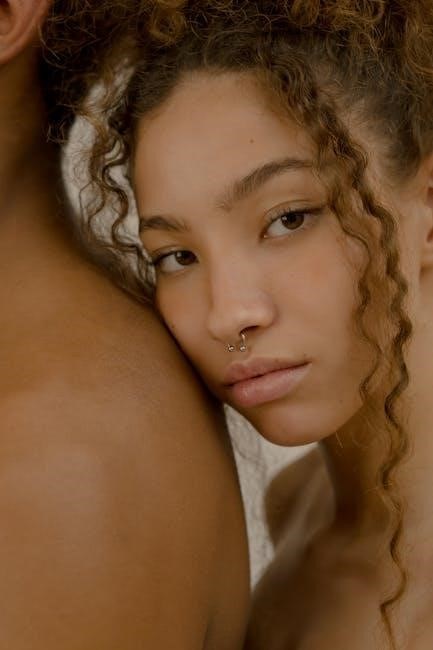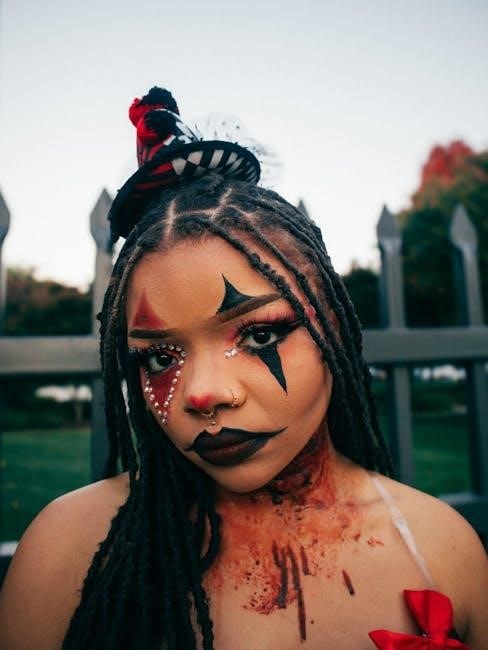Face piercings are a popular form of self-expression, offering a way to enhance personal style and beauty. They involve puncturing specific facial areas to insert jewelry, creating a unique aesthetic. With various types like eyebrow, nose, and lip piercings, individuals can choose designs that complement their features and preferences. Proper aftercare and finding a reputable piercer are essential for a safe and successful experience.
1.1. Definition and Popularity of Face Piercings
Face piercings involve puncturing specific facial areas to insert jewelry, serving as a form of self-expression and personal style enhancement. They have gained significant popularity globally, particularly among younger generations, as a way to showcase individuality and cultural influence. Common types include eyebrow, nose, and lip piercings, each offering unique aesthetic appeal and cultural significance.
1.2. Brief History and Cultural Significance
Face piercings have been practiced across various cultures for centuries, often symbolizing spiritual, tribal, or status-related significance. Ancient civilizations used piercings to signify strength, beauty, or religious beliefs. Today, they serve as a modern form of self-expression, blending historical influences with contemporary style to create a unique identity for individuals worldwide.

Popular Types of Face Piercings
Common face piercings include eyebrow, nose, lip, dermal, and bridge piercings. Each offers unique styling options, from subtle studs to bold rings, catering to diverse preferences.
- Eyebrow Piercing
- Nose Piercing
- Lip Piercing
- Dermal Piercing
- Bridge Piercing
2.1. Eyebrow Piercing
An eyebrow piercing is a popular choice, typically placed just below the eyebrow. It can be subtle with a small stud or bold with a ring. Placement varies, from the inner corner to the outer brow, offering versatility. Healing usually takes 6-8 weeks with proper care. This piercing allows for creative expression while maintaining a clean, edgy look.
- Versatile placement options
- Suitable for various jewelry styles
2.2. Nose Piercing (Nostril and Septum)
Nose piercings are among the most popular facial piercings, with options like nostril and septum. Nostril piercings involve piercing the nostril, often with a stud or ring, while septum piercings target the thin cartilage between the nostrils. Both styles are versatile, allowing for subtle or bold jewelry choices. Healing times vary, with nostril piercings typically taking 3-6 months and septum piercings healing faster, around 1-3 months.
- Popular for their versatility
- Suitable for various jewelry styles
2.3. Lip Piercing (Labret, Monroe, and Snake Bites)
Lip piercings offer bold, eye-catching designs, with options like Labret, Monroe, and Snake Bites. Labret piercings are placed below the lip, while Monroe piercings mimic Marilyn Monroe’s iconic mole. Snake Bites feature two symmetrical piercings on the lower lip. These styles allow for versatile jewelry choices, from subtle studs to decorative rings, making them a popular choice for self-expression.
- Labret: Below the lip
- Monroe: Inspired by Marilyn Monroe
- Snake Bites: Symmetrical lower lip piercings
2.4. Dermal Piercing
Dermal piercings involve inserting a single point under the skin, creating a subtle, gem-like appearance. Commonly placed on the forehead, cheeks, or chin, they offer a minimalist aesthetic. The procedure uses a dermal punch to create a small pocket for the jewelry. Aftercare involves gentle cleaning to promote healing and prevent complications, with jewelry options like dermal tops or anchors.
- Single-point piercing under the skin
- Popular for forehead, cheeks, or chin
- Requires proper aftercare for healing
2.5. Bridge Piercing
Bridge piercings are bold and eye-catching, placed horizontally across the nasal bridge. They typically use a surface bar or curved barbell. Healing can take 6-12 months, requiring meticulous aftercare. Proper placement is crucial to avoid discomfort. This piercing adds a striking detail to the face, appealing to those seeking a unique aesthetic with a subtle yet noticeable flair.
- Placed horizontally on the nasal bridge
- Uses surface bars or curved barbells
- Healing period: 6-12 months

Choosing the Right Piercing for Your Face
Selecting the perfect face piercing involves understanding your face shape, features, and personal style. Consider how the piercing will complement your natural aesthetic and lifestyle.
3.1. Understanding Face Shapes and Piercing Placement
Face shapes—round, oval, square, and heart—play a crucial role in selecting piercings. Round faces benefit from angular piercings like eyebrow or septum, while oval faces suit most styles. Square faces soften with curved piercings, and heart-shaped faces balance with lower placements. Symmetry and personal features guide optimal placement for a harmonious look. A professional piercer can help determine the best fit.
3.2. Considering Personal Style and Preferences
Choosing a piercing that aligns with your personal style ensures a look that feels authentic. Consider whether bold, subtle, or statement-making designs resonate with you. Think about your lifestyle, career, and daily activities when selecting a piercing. Your skin type and jewelry preferences also play a role. Reflect on your aesthetic goals to find a piercing that enhances your unique beauty and confidence.

The Piercing Process
The piercing process involves finding a reputable piercer, preparing properly, and undergoing the procedure safely. It requires attention to hygiene and precision for a positive experience.
4.1. Finding a Reputable Piercer
Finding a reputable piercer is crucial for a safe and successful piercing experience. Research local studios, check reviews, and ensure the piercer is licensed and experienced. Look for a clean, well-maintained environment and ask about their portfolio and hygiene practices. A professional piercer will guide you through the process and address any concerns, ensuring your comfort and safety throughout.
4.2. Pre-Piercing Preparation
Before getting pierced, maintain proper hygiene and avoid makeup or lotions on the area. Eat a light meal, stay hydrated, and avoid alcohol or caffeine. Remove any jewelry and consult your piercer about health conditions. Bring a friend for support and arrive early to complete paperwork. Ensure you’re well-rested for the best experience.
4.3. The Piercing Procedure
The piercer cleans the area with an antiseptic solution and marks the piercing spot. Using a hollow needle, they create the piercing, then insert the jewelry. The process is quick, though you may feel a pinch. Afterward, the piercer provides aftercare instructions to ensure proper healing. The entire procedure is precise and sanitized for safety.
Aftercare Tips for Face Piercings
Proper aftercare is crucial for healing. Clean the piercing with saline solution daily, avoid harsh products, and keep the area dry. Gently care for your piercing to prevent complications and promote healing;
5.1. Cleaning and Hygiene Practices
Regular cleaning is essential for proper healing. Use a saline solution to gently clean the piercing twice daily. Avoid harsh soaps or submerging the piercing in water. Keep the area dry and avoid touching it unnecessarily. Use clean hands when handling jewelry to prevent infections. Maintain hygiene to promote healing and minimize complications.
5.2. Common Mistakes to Avoid
Common mistakes include touching the piercing excessively, using harsh cleaning products, and over-cleaning, which can delay healing. Avoiding tight clothing and ensuring jewelry is the correct size is crucial. Ignoring aftercare instructions and using low-quality jewelry can lead to infections or prolonged healing times. Be mindful of these pitfalls to ensure a smooth recovery process.
Healing Times and Expectations
Healing times vary depending on the piercing type and location. Proper aftercare and jewelry quality significantly influence recovery. Patience is key for optimal healing outcomes and minimal complications.
6.1. Average Healing Periods for Different Piercings
Healing times vary by piercing type. Eyebrow piercings heal in 6-8 weeks, while nostril piercings take 2-3 months. Septum piercings typically heal within 6-8 weeks. Labret and Monroe piercings usually take 6-12 weeks, snake bites 6-8 weeks, dermal piercings 6-12 weeks, and bridge piercings 8-12 weeks. Proper care ensures faster healing and minimizes complications.
Proper healing is marked by reduced redness, swelling, and discharge. The piercing area should appear clean, with no signs of infection. Jewelry moves freely without causing irritation, and the surrounding skin feels smooth. Absence of pain or tenderness indicates healing progress. A foul odor or prolonged inflammation suggests complications, requiring immediate attention from a professional piercer.

Jewelry Options for Face Piercings
6.2. Signs of Proper Healing
Proper healing is indicated by reduced redness, swelling, and sensitivity. The piercing area should appear clean, with no discharge or odor. Jewelry moves freely, and the skin around the piercing feels smooth. If healing is progressing well, there should be no pain or irritation, and the piercing should look neat and well-integrated into the face.
7.1. Types of Jewelry Suitable for Face Piercings
Face piercings can be adorned with various jewelry types, including studs, rings, and labrets. Studs are ideal for septum and nostril piercings, while rings complement eyebrow and lip piercings. Labret jewelry is specifically designed for lip piercings, offering a sleek, minimalist look. Choose materials like surgical stainless steel or titanium for durability and hypoallergenic properties, ensuring both safety and aesthetic appeal.
7.2. Choosing the Right Jewelry Material
When selecting jewelry for face piercings, prioritize materials like surgical stainless steel, titanium, or 14k gold, which are hypoallergenic and durable. Avoid low-quality metals that may cause irritation. For initial piercings, opt for internally threaded or threaded jewelry to minimize discomfort and promote healing. Always ensure the material is biocompatible to prevent allergic reactions and ensure long-term comfort.
Potential Complications and Solutions
Common complications include infections or allergic reactions. Proper hygiene and high-quality jewelry can prevent these issues. Seek professional help if symptoms persist or worsen over time.
8.1. Common Issues and How to Address Them
Common issues with face piercings include infections, allergic reactions, or piercing bumps. To address these, practice proper hygiene with saline soaks, avoid tight clothing, and use hypoallergenic jewelry. If symptoms like redness or swelling persist, consult a professional piercer for guidance or medical attention to prevent further complications.
8.2. When to Seek Professional Help
Seek professional help if you experience severe swelling, increased redness, or persistent pain. If you notice discharge, pus, or jewelry migration, consult a piercer or doctor immediately. Ignoring these signs can lead to serious complications. Don’t hesitate to reach out if healing isn’t progressing as expected or if you suspect an infection.

Face Piercing Trends
Current trends include subtle studs, bold dermal piercings, and minimalist designs. Celebrities influence popularity, with many embracing lip, eyebrow, and nose piercings as statements of individuality and style.
9.1. Current Trends in Facial Piercings
Facial piercings are evolving with subtle studs and minimalist designs gaining popularity. Dermal piercings and unique placements are trending, offering bold statements. Celebrities influence trends, popularizing lip, eyebrow, and nose piercings. The rise of customizable jewelry and creative combinations allows individuals to express their uniqueness, making facial piercings a dynamic form of personal art and self-expression.
9.2. Celebrity Influences and Popularity
Celebrities significantly influence facial piercing trends, with icons like Rihanna and Kendall Jenner popularizing nose and lip piercings. Social media influencers and reality TV stars further amplify these styles, making them mainstream. Their bold choices inspire fans, driving demand for unique and eye-catching designs that reflect individuality and modern beauty standards.

Cost and Pricing Guide
Face piercings vary in cost, ranging from $30 for basic piercings to over $100 for intricate designs. Prices depend on the piercer’s expertise, location, and jewelry quality. High-end materials increase costs, ensuring a safe and stylish outcome.
10.1. Average Prices for Different Types of Face Piercings
Face piercings vary in cost, with eyebrow piercings typically ranging from $30 to $70, while nostril piercings cost between $40 to $90. Septum piercings can range from $60 to $100, and labret or Monroe piercings are usually priced between $50 to $120. Dermal and bridge piercings are more expensive, often starting at $80 and going up to $150 or more, depending on complexity and location.
10.2. Factors Affecting the Cost
The cost of face piercings is influenced by the piercer’s expertise, studio fees, and jewelry quality. Complex piercings, like dermal or bridge piercings, are pricier due to their difficulty. Location also plays a role, with urban areas often charging more. Additionally, aftercare products and follow-up services may add to the overall expense.

Face Piercing and Skin Type Considerations
Face piercings suitability varies by skin type; sensitive skin may require hypoallergenic jewelry, while oily skin might benefit from specific piercing types and aftercare routines.
11.1. Suitable Piercings for Different Skin Types
For sensitive skin, opt for hypoallergenic jewelry like titanium or surgical stainless steel to minimize irritation. Oily skin may benefit from piercings that avoid acne-prone areas, such as the eyebrow or bridge. Normal or combination skin can accommodate most piercing types, while dry skin may require extra moisturizing during healing. Consulting a professional piercer helps determine the best options for your skin type.
11.2. Managing Sensitive Skin
For sensitive skin, hypoallergenic jewelry like titanium or surgical stainless steel is recommended to reduce irritation. Gentle aftercare, such as using saline solutions, is crucial. Avoid harsh chemicals or tight clothing that may rub against piercings. Healing times may vary, so patience and consistent care are essential to prevent complications and promote healthy recovery.

The Role of Face Piercing in Self-Expression
Face piercings empower individuals to express their unique identity, values, and personal style. They serve as a creative outlet, allowing people to showcase their individuality and confidence through body art.
12.1. Personal Stories and Experiences
Many individuals share inspiring stories of how face piercings transformed their lives, fostering confidence and empowerment. For some, a simple eyebrow or lip piercing became a meaningful expression of identity, while others found healing and self-love through their journey with body art. These personal experiences highlight the profound impact of piercings on emotional well-being and personal growth.
12.2; Enhancing Individuality Through Piercings
Face piercings offer a powerful way to showcase individuality, allowing individuals to express their unique personality and style. By customizing piercing types, placements, and jewelry, people can tailor their look to reflect their identity. This form of self-expression empowers individuals to stand out, embracing their uniqueness and confidence, making piercings a meaningful tool for personal empowerment and creative freedom.

Maintenance and Upkeep
Maintenance is crucial for keeping face piercings clean and secure. Regularly clean jewelry, avoid harsh products, and handle piercings gently to ensure long-lasting beauty and comfort.
13.1. Long-Term Care Tips
For long-term care, clean piercings with saline solution daily and avoid harsh products. Handle jewelry gently and check its fit periodically. Keep skin hydrated and maintain good hygiene to prevent irritation. Regular check-ups with a piercer ensure optimal health and aesthetics, ensuring your piercings remain comfortable and visually appealing over time.
13.2. Jewelry Replacement and Upgrading
Replace or upgrade jewelry once piercings are fully healed, typically 6-12 months after piercing. Choose high-quality materials like surgical stainless steel or titanium for comfort and durability. Consider professional assistance for safe removal and installation. Opt for styles that complement your face shape and personal aesthetic, ensuring a secure and flattering fit.
Legal and Safety Considerations
Legal and safety considerations are crucial for face piercings. Ensure compliance with age restrictions and choose a reputable piercer who follows proper hygiene and safety protocols.
14.1. Age Restrictions and Regulations
Age restrictions for face piercings vary by region, typically requiring individuals to be at least 16 to 18 years old. Some studios require parental consent for minors. Ensure compliance with local laws and regulations before proceeding. Reputable piercers enforce these rules to ensure safe and legal practices for all clients.
14.2. Safety Standards to Look For
When choosing a piercer, ensure they follow strict hygiene practices, use sterile equipment, and have proper certifications. Reputable studios use autoclaves for sterilization and disposable needles. Jewelry should be high-quality and suitable for piercings. Verify that the piercer provides clear aftercare instructions to minimize risks and promote proper healing.
Face piercings offer a unique way to express individuality and enhance beauty. With proper care and a reputable piercer, they can be a lifelong statement of personal style and confidence.
15.1. Summary of Key Points
Face piercings are a vibrant form of self-expression, with options like eyebrow, nose, and lip piercings. Proper aftercare, finding a reputable piercer, and understanding healing times are crucial. Personal style, face shape, and jewelry choices play significant roles. With patience and care, piercings can enhance beauty and confidence, offering a unique way to showcase individuality and personal aesthetics successfully.
15.2. Encouragement and Final Advice
Embrace your uniqueness and confidently express yourself through face piercings. Research thoroughly, consult a professional piercer, and prioritize proper aftercare. Remember, piercings are a personal journey—choose what resonates with your style and confidence. With patience and care, your piercing can become a beautiful, lasting form of self-expression and individuality.
